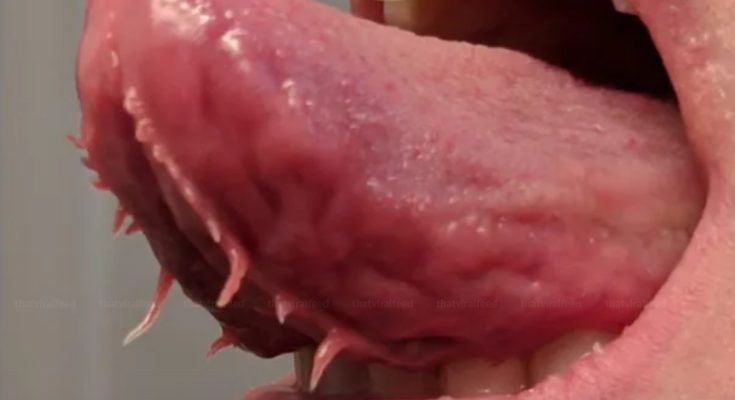Tongue tentacles are just harmless tissue remnants from development.
When you lift your tongue and look at the underside, you’ll notice two main things: the lingual frenulum (the thin tissue band connecting your tongue to the mouth’s floor) and two veins running alongside it.
Upon closer inspection, you might also spot raised folds near the veins. These are called fimbriated folds, or plica fimbriata, and they play a role in helping saliva drain from the sublingual and submandibular glands into your mouth.
For most people, these folds aren’t noticeable. However, for some, these folds can be more pronounced, with fringe-like bits sticking out up to 1 cm in length, often appearing in pairs.

This condition isn’t the result of any genetic inheritance or mutation. Instead, these fringes are simply leftover tissue from the tongue’s developmental phase that wasn’t fully absorbed by the body.
Even though these small “tentacles” might look unusual, they are completely harmless. The only downside is that they can occasionally get caught between the teeth, which can be slightly annoying.

Around 1 to 2.5% of the population experiences geographic tongue, with red patches that shift in size and position.
Another striking tongue condition is known as “geographic tongue.”
In this case, the surface of the tongue develops smooth, red patches where tiny bumps, called papillae, are missing. These red patches are surrounded by raised white lines and can change in size and shape over time, resembling a map that constantly shifts — which is where the name comes from.
While the condition might look alarming, a geographic tongue is harmless. Most people with this condition don’t experience any symptoms, though a few may notice mild discomfort when eating spicy or acidic foods.
“Fissured tongue” affects 5% of people, creating deep grooves and cracks on the tongue’s surface.
A fissured tongue develops deep grooves that run along its surface. The depth and pattern of these grooves can vary, with some tongues showing one deep fissure down the center, while others have multiple smaller fissures branching off.
This gives the tongue a cracked or scaly appearance. With a prevalence of around 5%, the likelihood of developing a fissured tongue increases as you age. This condition is usually caused by chronic irritation or vitamin deficiencies. Although it is mostly harmless, food particles can get trapped in the grooves, leading to irritation or discomfort.





